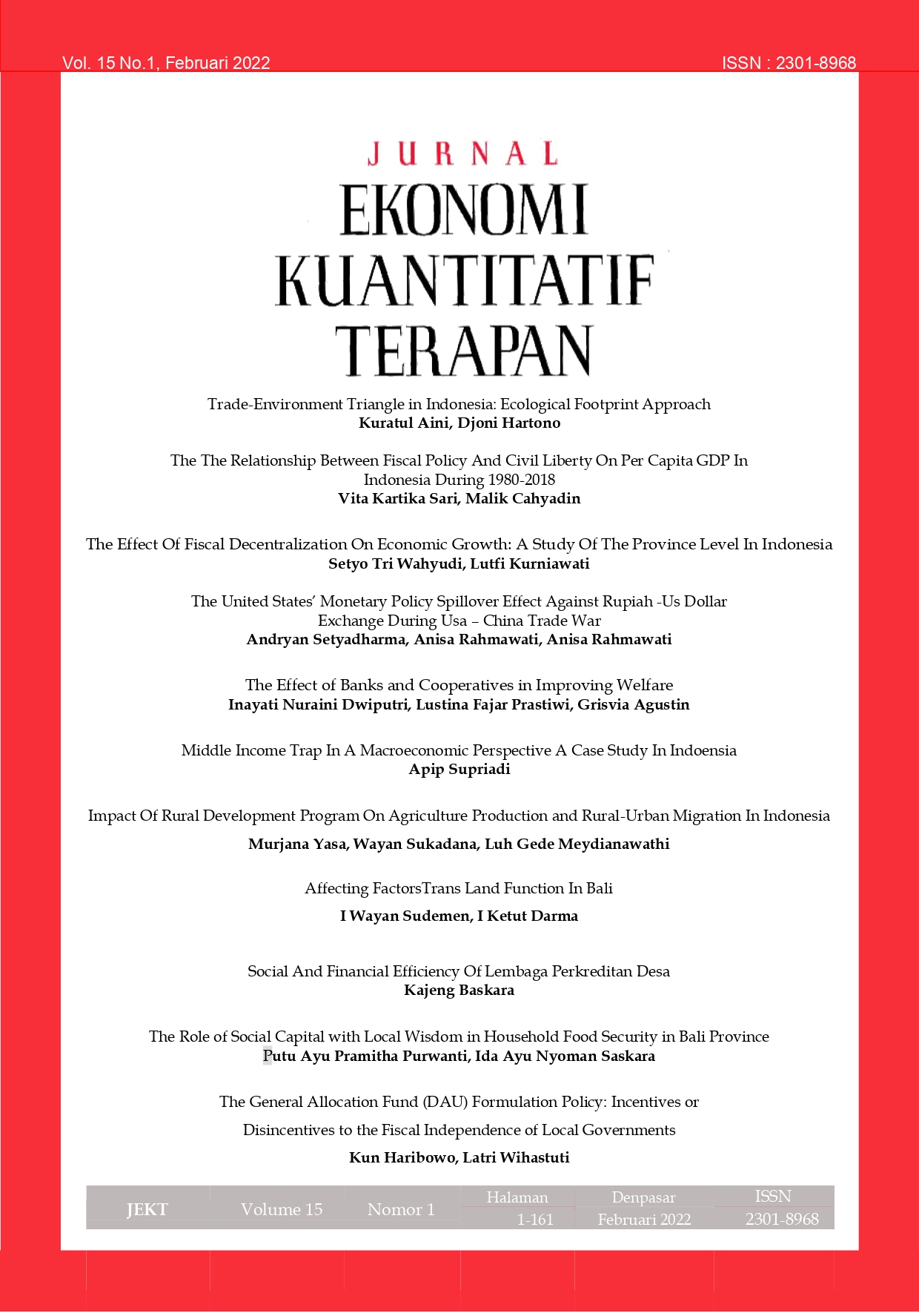The Effect of Banks and Cooperatives in Improving Welfare
Abstract
The use of cooperative credit in Indonesia is considered one of Indonesia's supporting economies. Generally, banks in Indonesia have a lower interest rate than cooperative loans. This study wants to identify the impact of cooperative credit on public welfare compared to bank loans. This study uses Indonesian Family Life Survey (IFLS) data with a regression analysis of fixed-effect methods at the village level. The results showed that the role of cooperative and bank credit did not have a significant difference in improving people's welfare. Cooperatives have an essential role in improving people's welfare as well as the bank. The higher the amount of credit taken; the more positive effect is on improving people's welfare. The use of credit for productive purposes also has a more positive influence on improving people's welfare than consumer credit.
Downloads
References
Bell, C., T. Srinivasan and C. Udry. (1997). "Rationing, Spillover, and Interlinking in Credit Markets: The Case of Rural Punjab". Oxford Economic Papers 49: 557-585.
Carter MR, and C Barrett. (2006). "The Economics of poverty: Traps and Persistent Poverty: An Asset-Based Approach", Journal of Development Studies 42 (2): 178-199.
Chandio, AA and Jiang, Y. (2018). "Determinants of Credit Constraints: Evidence from Sindh, Pakistan". Emerging Markets Finance and Trade 54 (15): 3401-3410.
Debela, M., Siriba, S. and Bekeley, H. (2017). "Impact of Cooperatives Membership on Economy in Eastern Oromia: the case of Haramaya Agricultural Farmers’ Cooperative Union (HAFCU)". Annals of Public and Cooperative Economics 89(2): 361-376.
Duflo, E. (2001). "Schooling and Labor Market Consequences of School Construction in Indonesia: Evidence from an Unusual Policy Experiment". The American Economic Review 91 (4): 795-813.
Dwiputri, I.N. (2017). "The Impact of the Unconditional Cash Transfer Program (BLT) on Cigarette Consumption in Indonesia Society". Journal of Indonesian Economy and Business 32(2): 138-150.
Dwiputri, I.N., Arsyad, L., and Pradiptyo, R. (2018). ”The Corruption-Income Inequality Trap: a study of Asian Countries” Economics Discussion Papers, No 2018-81, Kiel Institute for the World Economy.
Dwiputri, I.N., Pradiptyo, R., and Arsyad, L. (2019). "Corruption and Capital Growth: Identification of Bribery by the Firm", International Journal of Economics and Management 13(2): 467-479.
Gaisina, S. (2011). "Credit Policies for Kazakhstani Agriculture ", Central Asian Survey 30 (2): 257-274
Gertler, P., Legine, DI and Moretti, E. (2009). "Do Microfinance Programs Help Insure Families Against Illness?". Health Economics 18 (3): 257-273.
Grashuis, J and Su, Y. (2018). "A Review of the Empirical Literature on Farmer Cooperatives: Performance, Ownership and Governance, Finance, and Member Attitude". Annals of Public and Cooperative Economics 90 (1): 77-102.
Kaboski JP and Townsend RM (2011). "A Structural Evaluation of a Large-Scale Quasi-Experimental Microfinance Initiative". Econometrica 79 (5): 1357-1406.
Kaboski JP and Townsend RM (2012). "The Impact of Credit on Village Economies". American Economic Journal of Applied Economics 4 (2): 98-133.
Khafagy, A. (2018). "Finance, Distribution and the Economic Objective of Financial Cooperative Institutions". Annals of Public and Cooperative Economics 90 (3): 487-511.
Khandker, SR (2005). "Microfinance and Poverty: Evidence Using Panel Data from Bangladesh". The World Bank Economic Review 19 (2): 263-286.
Lahiri, B. and Tian Xi. (2013). "Structural Break Between Small and Large Firms' Behavior in Trade Credit and Bank Credit: Evidence from India's Retail Sector". Applied
Economics Letters 20 (2): 199-202.
Langley, P. (2014). "Consuming Credit". Consumption Markets & Culture 17 (5): 417-428.
Lal, T. (2017). "Impact of Financial Inclusion on Poverty Alleviation Through Cooperative Banks". International Journal of Social Economics 45 (5): 808-828.
Lal, T. (2018). "Measuring Impact of Financial Inclusion Through Cooperatives on Rural Development". International Journal of Social Economics 46 (3): 352-376.
Madestam, A. (2014). "Informal Finance: A Theory of Moneylenders". Journal of Development Economics 107 (2014): 157-174.
Ogundeji, AA, Donkor, E., Motsoari, C., and Onakuse, S. (2018). "Impact of Access to Credit on Farm Income: Policy Implications for Rural Agricultural Development in
Lesotho". Agrekon 57 (2): 152-166.
Pradiptyo, R., Sugiyanto, C., Sumiyana, and Dwiputri, IN (2013), "Optimal Network for BPD Regional Champion (BRC) to Support Financial Inclusion", SEADI Discussion Paper Series.
Schmidt, O. (2016). "How Cooperative Are Savings and Credit Cooperatives in Developing Countries?: An Analysis of Datasets From Uganda". Annals of Public and Cooperative Economics 88(3): 345-368.
Sanchis-Palacio, J.R. and Melian-Navarro, A. (2011). "Strategic Diagnosis of Spanish Farming Cooperative Credit Sections: A SWOT Analysis". Annals of Public and Cooperative Economics 82(2): 167-186.
Setyari, Ni Putu Wiwin. (2012). "Impact Evaluation of Microcredit on Household Welfare in Indonesia". Jurnal Ekonomi Kuantitatif Terapan 5 (2): 141-150. Faculty of Economics, University of Udayana.
Su, Y. and Cook, M.L. (2020). "Advances in Agriculture Research Since 2007: A Review of Chinese Agricultural Economics Literature". Annals of Public and Cooperative Economics 91(4): 519-543.
Todaro, MP and Smith, SC (2012). "Economic Development", 11th edition. Addison-Wesley, Pearson.
Wassie, S.B., Kusakari, H. and Masahiro, S. (2019). "Inclusiveness and Effectiveness of Agricultural Cooperatives: recent evidence from Ethiophia". International Journal of Social Economics 46(5): 614-630.
Wooldridge, JM (2003). "Introductory Econometrics: A Modern Approach", Second Edition.




















